We can all agree that the COVID-19 global pandemic has been a catalytic event when it comes to talent management.
Businesses and employees were forced to work differently for almost two years, which revealed that the impossible was possible and accelerated the adoption of new technologies and ways of working.
But, while the right conversations have been occurring in most companies, we have only seen efforts and resources poured into isolated initiatives that have had a marginal improvement to the overall employee experience and employee engagement outcomes (e.g. hybrid work or restricted flexibility).
When it comes to transforming talent management, it’s not a game of either/or but a strategic choice of AND. If companies are serious about winning the so-called “war on talent,” they must embrace the systemic nature of talent management.
In order to really move the needle and create sustainable change, businesses must consider multifaceted and integrated changes to talent management structures, talent-related key processes, talent management metrics, people skills AND corporate culture.
Addressing just one or a few of the dimensions within the talent management system will only create a short-term illusion of progress.
For example, a company may be able to attract great talent due to a strong buzz about their mission-driven set of initiatives, but without reengineering their employee performance process and career development pathways they won’t be able to retain that great talent.
So, where to start?
1. Following a system-thinking approach, develop your integrated and multifaceted roadmap (more on this below).
For example, many companies are putting a lot of effort into recruiting diverse talent, but many fail to connect that to talent metrics such as innovation. As a consequence, diversity recruiting becomes a “checkbox” activity that is not linked to any business outcome.
2. Align the entire senior leadership team around the roadmap
The plan would not be complete without a strong link to the company’s strategy and business outcomes. Avoid developing the plan only within the walls of the HR function. The ownership of the plan must be shared among senior leadership and they must hold themselves accountable to it. It should not be “just an HR thing”!
3. Double down on corporate culture
Culture is the glue that holds everything together, so make sure enough effort is put into achieving the culture that will enable your talent management roadmap. Without that, nothing will stick.
Building The Roadmap
Businesses are ecosystems just like the human body, representing a complex network of interconnected systems.
Each of these systems represents a set of parts working together to fulfill a specific purpose. Thus, when trying to solve a problem within any one system, we must do a deep dive into each supporting part in order to find the solution. In the world of talent management, these are the organizational dimensions that I describe below.
Having the right talent to enable the evolution and growth of your organization requires companies to analyze three questions: how talent decisions are made, how talent potential is identified and developed, and how effective leadership is at managing talent.
To address all three of those questions, we must look at five organizational dimensions, or parts, within our talent management system, as shown in the picture below.
Keep in mind, the answers will vary among different companies, but the key is ensuring that there is a strong alignment between all five components.

To drive sustainable change, you must address ALL five organizational dimensions within your talent management roadmap. There is a cause-and-effect relationship among all five of those dimensions, so it’s important to understand the interdependencies within the system.
Remember you are trying to win the “war in talent”, not just one or two battles. I’ll unpack each element in a bit more detail.
Structure
As human beings, we tend to hire people similar to ourselves or what we’re used to seeing. Thus, when the decision of hiring is owned by just one individual, the risk of “cloning” increases. Ensuring hiring decisions are divided between a group of individuals helps decrease such risk and builds shared ownership (“our talent”).
Key Processes
Building shared ownership is not enough if talent decisions aren’t directly linked to the company’s strategic direction. Talent decisions are not made to fix the past but are made to enable the future of an organization.
Therefore, it’s critical to establish a robust workforce planning process that is continuously adapting to the dynamic demands of the environment.
Equally important is to reimagine the talent performance review process so it can help the organization identify talent potential and fuel its growth.
Performance review processes built on the basis of popularity contests versus employee skills won’t support the company’s growth because the wrong people are rewarded (the “groupie effect”). Talented people won’t stick around if they feel they are being assessed unfairly.
Metrics
Every system requires a feedback loop so it can continuously adapt and improve. The talent management system is no exception, but, in many cases, a lot of the wrong things are being measured.
Building shared talent ownership and some terrific workforce planning processes won’t matter if the talent management system doesn’t generate the right outcomes.
Thus, we must be diligent in identifying the right set of metrics that can signal whether the system is working well and adequately identify areas of improvement.
By shifting attention to leading organizational indicators that are directly linked to the company’s strategy, we give our talent management system the best chance to succeed.
For example, your talent management system should be measuring innovation, learning agility, and adaptability or change resilience.
Pro tip: remember you are measuring the success of a system and not of an individual.
People Skills
This is a very trendy topic lately. There are some excellent discussions about organizational skills as well as how to identify and monitor them.
The phrase “skills as the new currency” is spot on and I hope those discussions are already taking place at your company.
However, it’s not just about the skills that people bring to the organization, but also the skills employees can develop and grow once inside the organization.
Career development opportunities are a strong motivator for top talent, thus the reason why our talent management system must ensure to provide them.
Those career opportunities should offer a wide range of pathways and personalized avenues to support and attract a diverse employee base and a constantly evolving business environment.
Career pathways must be aligned and aimed toward the talent management measures chosen in the previous step—otherwise, the company may be developing a lot of talent it doesn’t need.
Culture
Last but not least is culture or, in other words, our collective beliefs. Culture is the glue that holds everything together, so without a collective belief that supports the chosen people's skills, measures, key processes, and structure, there will be no chance for sustainable talent management changes.
The key to evolving a company’s collective beliefs is its leadership. Focusing on developing the right leaders with a consistent set of corporate mindsets is fundamental for the success your talent management system.
It’s the leaders of a company who nurture the collective beliefs of an organization, which is why any organization must always invest in its leaders.
So, What’s Next?
If you aren’t getting what you need from your existing talent management plan, I would strongly encourage you to do something different and follow my previous recommendations.
You will not generate different outcomes by continuing to do the same things. Your talent management roadmap is a multiyear journey, so the sooner you start the better.
The so-called “war for talent” is only going to get more intense, therefore early adopters and risk-takers could develop a competitive advantage. The question is: are you in or out of this game?!
Feel free to ask any questions in the comments or connect with me via LinkedIn.
Some further resources to help you with your talent management:



